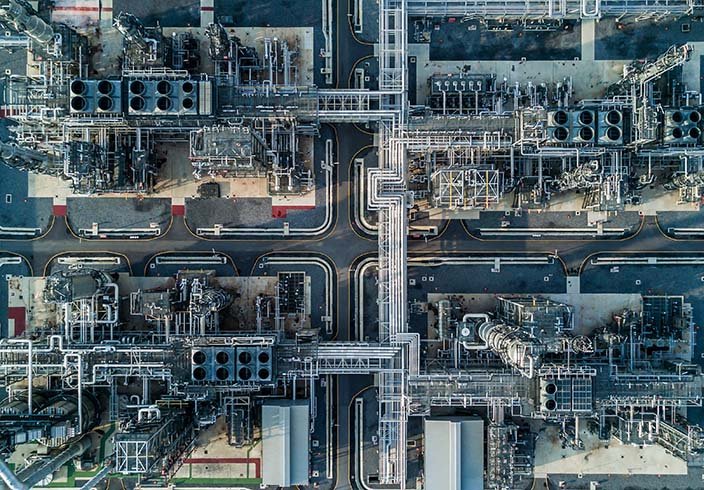Where does our energy come from? What helps us in the industrial sector to save electricity and make waste heat usable? And what makes us less dependent on fossil fuels and their sometimes highly controversial supplier nations? Energy efficiency in industry is of crucial importance today, and not only with regard to climate change – the topic is also highly relevant for our economy from an economic point of view.
In order to remain economically sound and competitive and to be able to act sustainably and transparently with regard to ESG criteria, a number of measures such as energy management systems and energy storage systems have been implemented or have reached market maturity in recent years.
The measures are designed to increase the energy efficiency of our industry while remaining affordable for companies and consumers. In terms of approach and implementation, scientists advocate a holistic, systemic approach and advise analyzing and improving industrial energy demand and use in its entirety.
What role does energy efficiency play in industry?
There’s no question about it: A lot of energy is consumed every day for industrial processes. Energy requirements are increasing with the electrification of processes, which is so valuable in terms of climate protection. After all, the move away from fossil fuels such as gas and oil comes at a price. If more electricity is consumed, this costs a lot of money per se – unless processes are used that buy energy cheaply, use it optimally and recycle it in the spirit of the circular economy.
Process heat is an important lever that, with the help of modern technologies, leads to greater energy efficiency and thus to lower costs and greater competitiveness in the long term.
Identifying savings potential with energy efficiency consulting
In order to optimize energy-intensive processes and make energy use in industry more efficient, the first step is to conduct as comprehensive a status quo analysis as possible. This is the only way to identify electricity-intensive processes and technologies and find possible alternatives.
As in private households, energy efficiency consulting is a sensible first step. Qualified experts visit the company, analyze data and processes, and make recommendations for maximizing energy efficiency. The prices for energy efficiency consulting vary depending on the size of the company and the energy costs incurred.
Examples for more energy efficiency in industry
There are various levers and starting points for achieving greater energy efficiency in industry. On the one hand, there is the fundamental saving of energy – especially through the use of technologies that make energy consumption measurable and can calculate and scale it precisely. On the other hand, however, it is also about the optimal use of purchased electricity and the use of waste heat, as made possible, for example, by thermal energy storage systems. The latter offer the great advantage that they enable the inexpensive purchase of regeneratively generated electricity, store it and release it again flexibly in the form of heat and steam. But waste heat can also be recovered in this way, which significantly maximizes the efficiency of the solution.
Energy management systems
The aim of an energy management system is to use digital technologies to precisely record and display a company’s energy management data. How much energy is consumed for what? The targeted measurement and control of a company’s energy flows are essential for energy-efficient management. The purpose of the digital system is to achieve a significant improvement in processes for reduced costs and more competitive advantages.
Building automation: Reducing energy consumption with smart buildings
While process heat accounts for a significant share of final energy consumption in the industrial sector, another area – albeit rather small in the industrial context – should not be ignored: Energy consumption in buildings. Here, too, there is a great deal of potential for savings with the help of modern automation solutions, for example when lighting and heating systems are controlled as required and electricity consumers automatically draw on existing, integrated self-power systems and storage solutions, such as solar panels or thermal batteries.
Saving energy through electrification
There is widespread consensus in the scientific community that decarbonization of industry cannot be achieved without extensive electrification of industrial processes – provided that the energy required for the electrified processes is also generated by renewable sources such as solar and wind power.
To ensure that energy is provided reliably and in an economically viable manner, thermal energy storage solutions such as ENERGYNEST’s ThermalBattery™ play an important role. The advantage: at times when the sun and wind are strong, the storage solutions can be refueled comparatively inexpensively with green energy, which is stored inside the battery in a special concrete. As needed, the energy can then be flexibly released again in the form of heat and steam – especially for industries that rely on high temperatures, this is an extremely flexible and economically viable solution that offers protection against price volatility and market price risks as well as fluctuating gas prices, CO2 compensation costs and grid balancing fees.
Utilize waste heat
Another advantage: The ThermalBattery™ can recapture a large part of the waste heat normally lost in industry and make it usable again in the form of process heat, steam, electricity or compressed air – new production cycles are supplied with green heat.
Various studies show how great the potential of industrial waste heat is. According to the specialist portal “Industrie Energieforschung”, for example, almost six million two-person households could theoretically be heated in a climate-neutral manner using the waste heat that can be used in Germany. The possible CO2 savings are correspondingly high. By using waste heat, almost as many emissions can be avoided per year as one third of the cars registered in Germany emit in the same period, according to the experts.
Costs for energy efficiency measures: Is the investment worthwhile for companies?
For policymakers and industry, the decarbonization of industry in general, and thus of course the research and implementation of energy efficiency measures, involves a considerable volume of investment – investment that will pay off in the long term. The economic consultancy McKinsey writes: “The savings from climate protection in the overall period up to 2045 can offset the costs of decarbonization. The prerequisites for this are a consistent switch to green technologies in all sectors of the economy and areas of life, as well as rapid action as early as the next ten years.”
The fact is that if you want to keep your energy costs low in the long term, you have to pay attention to efficiency. Against this background, energy consulting is a good place to start. But storage solutions, such as thermal batteries, can also make a significant contribution to increasing efficiency. Depending on the contract model, solutions such as ThermalBattery™ can be used entirely without investment costs and can be easily integrated into existing infrastructures and processes.



